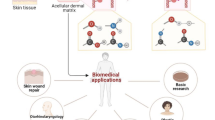Abstract
We have standardized the protocols for the development of acellular dermal matrix from sheep skin. Acellular dermal matrices are composed of extracellular matrix (ECM) and are typically derived by decellularization of native tissues. Sodium deoxycholate (SD), sodium dodecyl sulfate (SDS), Triton X-100, and Tween 20 detergents in combination with trypsin enzyme are used to lyse the cells followed by rinsing to remove the cells. The decellularization was confirmed by histological examination. Treatment with 2% SD and 2% SDS for 24 h along with trypsin resulted in complete acellularity of the dermis. The results are more or less similar with these too detergents. We succeeded in preservation of three-dimensional ultrastructure of ECM which is highly desirable and requires proper decisions regarding the agents and techniques involved in the process.
Access this chapter
Tax calculation will be finalised at checkout
Purchases are for personal use only
Similar content being viewed by others
References
Mobini B (2015) Histological feature of the skin at different regions and in different ages of Lori-Bakhtiari sheep. Lebanese Sci J 16:89–95
Fourneau M, Caroline C, Vlaender DV, Collins MJ, Fiddyment S, Poumay Y (2020) Histological study of sheep skin transformation in the course of parchment manufacturing. Heritage Sci. https://doi.org/10.21203/rs.3.rs-28808/v1
Purohit S, Kumar N, Sharma AK, Sharma AK (2016) Development of acellular dermal matrix from skin of different species of animals using biological detergents and enzymes combinations. JSM Burns Trauma 1:1004
Courtman DW, Pereira CA, Kashef V, McComb D, Lee JM, Wilson GJ (1994) Development of a pericardial acellular matrix biomaterial-biochemical and mechanical effects of cell extraction. J Biomed Mater Res 28:655–666
Wainwiright DJ (1995) Use of an acellular allograft dermal matrix (Alloderm) in the management of full-thickness burns. Burns 21:243–248
Livesey SA, Campo AA, Nag A, Nichols KB, Coleman C (1994) Method for processing and preserving collagen-based tissues for transplantation. US Patent#5,336,616 Life Cell Corporation, 23-24
Seddon AM, Curnow P, Booth PJ (2004) Membrane proteins, lipids and detergents: not just a soap opera. Biochim Biophys Acta 1666:105–117
Gilbert TW, Sellaro TL, Badylak SF (2006) Decellularization of tissues and organs. Biomaterials 27:3675–3683
Ben-Bassat H, Chaouat M, Segal N, Zumai E, Wexler MR, Eldad A (1993) How long can cryopreserved skin be stored to maintain adequate graft performance? Burns 27:425–431
Weber RA, Proctor WH, Warner MR, Verheyden CN (1993) Autonomy and the sciatic functional index. Microsurgery 14:323–329
Booth C, Korossis SA, Wilcox HE, Watterson KG, Kearney JN, Fisher J et al (2002) Tissue engineering of cardiac valve prostheses I: development and histological characterization of an acellular porcine scaffold. J Heart Valve Dis 11:457–462
Livesey SA, Herndon DN, Hollyoak MA, Atkinson YH, Nag A (1995) Transplanted acellular allograft dermal matrix. Potential as a template for the reconstruction of viable dermis. Transplantation 60:1–9
Jiang DY, Chen B, Jia CY, Tao K (2003) An experimental study on the difference of the antigenicity of xenogeneic acellular dermal matrix. Zhonghua Shao Shang ZaZhi 19:155–158
Chai JK, Liang LM, Yang HM, Feng R, Yin HN, Li FY et al (2007) Preparation of laser micropore porcine acellular dermal matrix for skin graft: an experimental study. Burns 33:719–725
Samouillan V, Dandurand-Lods J, Lamure A (1999) Thermal analysis characterization of aortic tissues for cardiac valve prostheses. J Biomed Mater Res 46:531–538
Raghuvansi PDS (2018) Reconstruction of full thickness skin wounds in rats by cell adhesion peptide (CAP) fabricated bioengineered caprine forestomach matrix (CFM). PhD thesis submitted to Deemed University, Indian Veterinary Research Institute, Izatnagar
Sangetha P, Maiti SK, Kumar N, Singh K, Gopinathan A, Ninu AR, Remya V, Shivanarayan TB, Mohsina A, Tamilmahan P, Mohan D (2015) Development of bioengineered porcine small intestinal submucosal scaffolds for reconstructive surgery. Trends Biomater Artif Organs 29:146–150
Raghuvanshi PDS, Mohan D, Gautam D, Shivaraju S, Maiti SK, Kumar N (2018) Clinical application of animal based extracellular matrix in hernioplasty. MOJ Imunol 6:115–118
Singh AK, Kumar N, Shrivastava S, Singh KP, Dey S, Raghuwansi PDS, Singh AP (2018) Evaluation of the efficacy of bubaline rumen derived extracellular matrix in umbilical hernioplasty in buffalo calves. Int J Fauna Biol Stud 5:29–33
Parizek J, Mericka P, Husek Z, Suba P, Spacek J, Nemecek S, Nemeckova J, Sercl M, Elias P (1997) Detailed evaluation of 2959 allogeneic and xenogeneic dense connective tissue grafts (fascia lata, pericardium, and dura mater) used in the course of 20 years for duraplasty in neurosurgery. Acta Neurochir (Wien) 139:827–838
Lun S, Irvine SM, Johnson KD, Fisher NJ, Floden EW, Negron L (2010) A functional extracellular matrix biomaterial derived from ovine forestomach. Biomaterials 31:4517–4529
Author information
Authors and Affiliations
Editor information
Editors and Affiliations
Rights and permissions
Copyright information
© 2022 The Author(s), under exclusive license to Springer Science+Business Media, LLC, part of Springer Nature
About this protocol
Cite this protocol
Kumar, N. et al. (2022). Tissue Scaffolds Derived from Sheep Skin. In: Kumar, N., Kumar, V., Shrivastava, S., Gangwar, A.K., Saxena, S. (eds) Tissue Scaffolds. Springer Protocols Handbooks. Humana, New York, NY. https://doi.org/10.1007/978-1-0716-2425-8_5
Download citation
DOI: https://doi.org/10.1007/978-1-0716-2425-8_5
Published:
Publisher Name: Humana, New York, NY
Print ISBN: 978-1-0716-2424-1
Online ISBN: 978-1-0716-2425-8
eBook Packages: Springer Protocols




